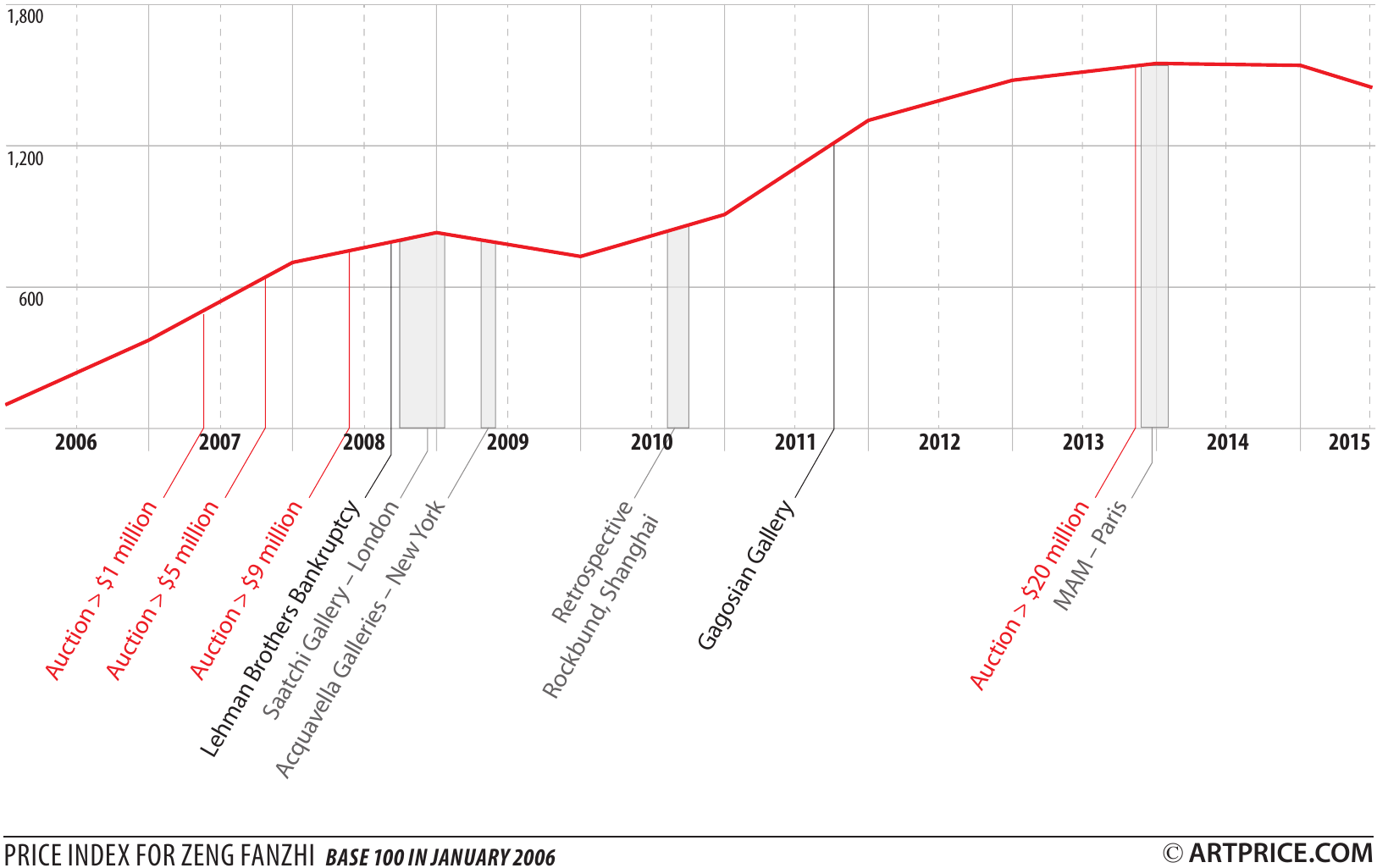ZENG Fanzhi – the Chinese Emperor
In 1991 ZENG Fanzhi was just 27. He was studying at the Hubei Academy in the Wuhan province, approximately 800 kilometres from Shanghai. At the school of Fine Art, his teachers taught him about the Montmartre artists…Picasso, Matisse, the Surrealists, but he seems to have been most influenced by the German Expressionist painters, impressed by the anxiety and decadence that exuded from their works.
Once graduated, the young artist left for Beijing in 1993 where he fell into an extraordinarily dynamic creative environment – he was spotted by the Marlborough Gallery which subsequently included some of his works in two London exhibitions1 in 1993 and 1994. In London, he was spotted by Myriam and Guy Ullens de Schooten Whettnall. At the time, the Ullens couple were not yet famous and ZENG Fanzhi had no idea he was selling to pioneers of Contemporary Chinese art who later established the first private Art Centre in China2. The Ullens subsequently acquired numerous works by ZENG Fanzhi, including The Last Supper, which in 2013 elicited enthusiastic bidding, fetching $23million3.
Before reaching that zenith and before becoming the most expensive Chinese Contemporary artist on the market, Zeng Fanzhi was exclusively acquired by Western collectors until 2000. His first exposure to the secondary market took place in London in 1998, but it was too soon … The first two works were bought in despite being offered for less than $10,000. One of them, The mask Series, No.10, subsequently fetched $1.1million amidst excited bidding in 20124.
As of 2005, ZENG Fanzhi’s market broadened with collectors from Taiwan, Hong Kong and Singapore. At the time he was exhibited by Hanart TZ, a highly reputed gallery in Hong Kong, whose director Chang Tsong-zung ( Johnson Chang for the Westerners) is a major pioneer in the field of Contemporary Chinese art. In the following years, Chinese artists were supported by a booming population of local art buyers coupled with Western buyers seduced by the huge potential of the new Chinese market. After November 2005, Fanzhi’s auction prices started to snowball, sometimes fetching ten times their estimates. In 2007, various highly reputed Chinese collectors began acquiring works by ZENG Fanzhi and his prices rocketed. His first result above the million-dollar line was hammered in Hong Kong in May of that year (at 12 times the low estimate), and the 7-digit level was confirmed the following month with another million-plus result in London5. Since then, Fanzhi has generated over one hundred results above the million-dollar line.
In 2008, ZENG Fanzhi further strengthened his market power when Christie’s managed to sell his Mask series 1996 No.6 for no less that $9.6 million (three times the high estimate6) at its first sale of Contemporary Asian art in Hong Kong. Five years later, the artist earned another auction record when his The Last Supper, a giant canvas from the now famous Guy and Myriam Ullens Collection, added $13.6million to his previous record. After approximately fifty bids, the buyer obtained the most expensive work of Contemporary Chinese art ever sold at auction ($23 million).

With the advent of the financial crisis, his sales, like many others’, substantially contracted: on 30 November 2008, a work of the same calibre as Mask series 1996 No.6, entitled From the Masses, to the Masses, failed to sell. The following day Christie’s Contemporary art sale generated a 43% unsold rate… However ZENG Fanzhi’s prices rapidly recovered, supported by some of the world’s most powerful dealers and collectors and an energetic programme of exhibitions: in 2008 he showed at the Saatchi Gallery7, then at New York’s Acquavella in 2009, then Venice in 2011 (Francois Pinault), then London’s Gagosian in 2012, then Paris’s Musée d’Art Moderne8 in 2013, and the Louvre in 2014… Unlike some of his compatriots, his aura of prestige has proved extremely resilient. Over the last year9, 41 ZENG Fanzhi paintings have sold at auction, and 41% of these fetched above the million-dollar line10…
ZENG Fanzhi’s prices have stabilised and collectors, no longer disoriented by his style changes, are continuing to invest in other series besides his Masks and Hospital series. The common theme of ZENG Fanzhi’s series remains an East-West dialogue, particularly in his landscapes lacerated by frenetic brush strokes. Through his work depicting a damaged environment, ZENG Fanzhiis lending his notoriety to a noble cause and hopes to raise his compatriots’ awareness of ecological issues. Far from demagogical, this stylistic departure reflects his childhood in the city of Wuhan, which has become sadly renowned for its thick clouds of pollution, its suffocating heat and its highly polluted water. In China, ZENG Fanzhi represents a model of success and he is planning to open his own museum in Beijing.
- Both titled New Art From China.
- The Ullens Center for Contemporary Art (UCCA) opened in 2007 in Beijing’s 798 Art District.
- Sotheby’s Hong Kong, 5 October 2013.
- Christie’s Hong Kong, 24 November 2012.
- Mask Series N°8 fetched $1.6 million including fees at Christie’s Hong Kong on 27 May 2007, then Hospital Series fetched $1.7 million including fees at Phillips de Pury & Company in London on 22 June 2007.
- Christie’s Hong Kong, 24 May 2008.
- The Revolution Continues, New Art From China, Saatchi Gallery, London.
- ZENG Fanzhi from 18 October 2013 to 16 February 2014.
- Between July 2014 and July 2015.
- Including fees.





 0
0
